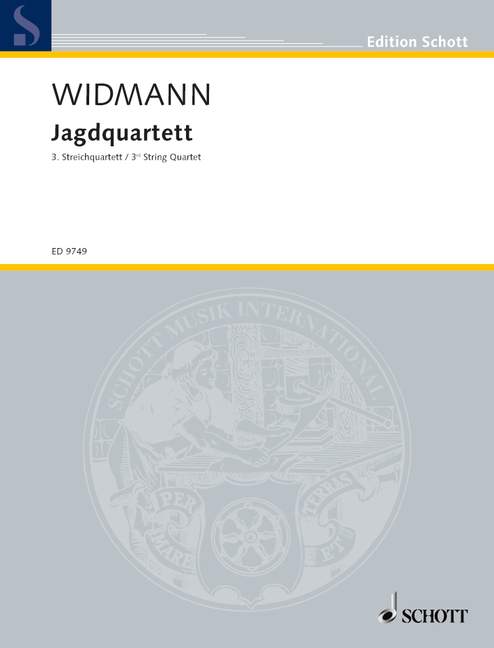Widmann: String Quartet No. 3 ("Hunting Quartet")
In stock and typically ships within 1 business day.
- Composer: Jörg Widmann (1973-)
- Instrumentation: String Quartet (Violin I, Violin II, Viola, Cello)
- Work: String Quartet No. 3 (Hunting Quartet)
- ISMN:
- Size: 9.1 x 11.9 inches
- Pages: 114
Description
The Jagdquartett (Hunt Quartet), which Jörg Widmann wrote as his third string quartet in 2003, following the Choralquartett, also begins with a visible gesture. After a short signal cry from the performers, the piece starts by quoting Robert Schumann's Papillons, Op. 2, and for its full duration retains this gesture, these starting sounds. The degrees of recognizability do change continuously, to be sure, in the furious, racing organism of the score. The contours change into forms on another level, yet now and then the begining material returns clearly to the fore, initiated anew by a cry from the performers, and is then digested or mutated as a rhythmic study into a field of harmonic experimentation. On rare occasions, there are moments of pause - as though the musicians were testing the atmosphere, as though they were sensing the weather, so as ultimately to continue playing the quartet across the fields an forests of notes. A hunt after joyful performance, a chase, the whip cracking, after the thing to be shot, the sound, its performer, perhaps the composer himself? - A last shout, morendo, dal niente... - The victim is not the audience, at any rate. When comparing the output of string quartets from the 18th century to the time of Schumann, it appears to have dropped considerably. Schumann composed only three complete quartets, all of them in the so-called ‘chamber music year' 1842. Jörg Widmann, who counts Robert Schumann among his greatest inspirations, finished a series of five string quartets in 2005, at the same age as Schumann. The quartets in the cycle form in themselves the characters of the movements of the classical quartet. Jagdquartett represents the fast middle movement, the scherzo. Widmann‘s work appears rough and wild in the style of Schumann's alter ego Florestan. His hunt begins in the tempo of ‘allegro vivace assai' with the final theme of Schumann‘s Papillons which often appears or is cited in many of Schumann's compositions. Widmann eventually dismantles the thematic material of his fierce quartet, thus skeletonising his prey.
Publishers use a lot of words to describe what they sell, and we know it can be confusing. We've tried to be as clear as possible to make sure you get exactly what you are looking for. Below are descriptions of the terms that we use to describe the various formats that music often comes in.
Choral Score
A score for vocalists that only contains the vocal lines. The instrumental parts are not there for reference. Generally, cheaper than a vocal score and requires multiple copies for purchase.
Facsimile
Reproductions of the original hand-written scores from the composer.
Full Score
For ensemble music, this indicates that the edition contains all parts on a single system (there are not separate parts for each player). In larger ensembles, this is for the conductor.
Hardcover
Hardbound. Generally either linen-covered or half-leather.
Orchestral Parts
Similar to a wind set, this is a collection of parts. In the case of strings, the numbers listed are the number of copies included, though generally these are available individually (often with minimum quantities required).
Paperback
When publishers offer multiple bindings (e.g. hardcover) or study scores, this is the "standard" version. If you're planning to play the music, this is probably what you want.
Performance / Playing Score
A score of the music containing all parts on one system, intended for players to share. There are not separate parts for each player.
Set of Parts
For ensemble music, this indicates that there are separate individual parts for each player.
Solo Part with Piano Reduction
For solo pieces with orchestra, this is a version that contains a piano reduction of the orchestra parts. For piano pieces, two copies are typically needed for performance.
Study Score
A small (think choral size) copy of the complete score meant for studying, and not playing. They make great add-ons when learning concertos and small chamber works.
Vocal Score
A score prepared for vocalists that includes the piano/organ part or a reduction of the instrumental parts.
Wind Set
For orchestral music, this is a collection of wind and percussion parts. The specific quantities of each instrument are notated.
With Audio
In addition to the printed music, the edition contains recordings of the pieces. This may be an included CD, or access to files on the internet.
With / Without Fingering (Markings)
Some publishers prepare two copies - a pure Urtext edition that includes no fingering (or bowing) suggestions and a lightly edited version that includes a minimal number of editorial markings.


